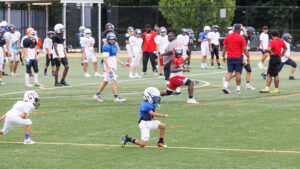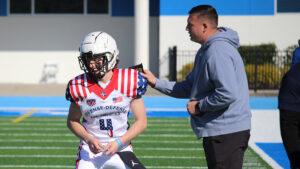Football is a dynamic and physically demanding sport that requires a combination of skill, strategy, and teamwork. Whether you’re coaching a youth league team or a college squad, effective practice drills are essential for developing players’ abilities and building a cohesive unit. From honing fundamental techniques to fostering camaraderie among teammates, the right drills can make all the difference on game day.
In this blog post, we’ll explore some of the best football drills for coaches to incorporate into their practice sessions. These drills are designed to enhance players’ agility, speed, coordination, and teamwork, laying the groundwork for success on the gridiron. Let’s dive in and discover the key drills that every football coach should have in their playbook.
Agility Ladder Drills: Agility is a crucial aspect of football, allowing players to change direction quickly and evade opponents. Agility ladder drills help improve footwork, coordination, and overall agility. Incorporate ladder drills such as the two-in, two-out drill, the lateral shuffle, and the Ickey Shuffle into your practice routine.
Tackling Drills: Proper tackling technique is essential for preventing injuries and stopping opponents in their tracks. Tackling drills focus on fundamentals such as leverage, form, and tackling angles. Include drills like the tackling ring drill, the angle tackling drill, and the pursuit drill to reinforce sound tackling technique.
Passing and Catching Drills: A strong passing game can be a game-changer on the football field. Passing and catching drills help quarterbacks develop accuracy and timing while receivers improve their hands and route-running abilities. Consider drills like the one-handed catch drill, the quarterback footwork drill, and the route tree drill to fine-tune passing and catching skills.
Blocking Drills: Blocking is the cornerstone of a successful offense, creating opportunities for ball carriers to advance down the field. Blocking drills emphasize proper technique, leverage, and teamwork among offensive linemen and tight ends. Incorporate drills such as the blocking pad drill, the sled drill, and the double-team drill to strengthen blocking fundamentals.
Ball Security Drills: Possession of the football is paramount in football, and ball security drills help reduce turnovers and maintain possession. Focus on drills like the gauntlet drill, the ball security circuit, and the turnover circuit to reinforce proper ball-carrying technique and awareness.
Conditioning Drills: Football is a physically demanding sport that requires players to be in top-notch condition. Conditioning drills help build endurance, speed, and stamina, ensuring that players can perform at their peak throughout the game. Include drills like the shuttle run, the gasser drill, and the interval sprint drill to improve overall fitness levels.
These essential football drills form the foundation of effective practice sessions, helping players develop the skills, techniques, and teamwork necessary for success on the gridiron. In the subsequent sections, we’ll delve deeper into each drill, providing detailed instructions and tips for coaches looking to elevate their team’s performance. Stay tuned as we explore the ins and outs of mastering the gridiron!
Agility Ladder Drills
Agility ladder drills are fundamental exercises in football training due to their ability to enhance players’ agility, footwork, coordination, and overall athleticism. These drills simulate the rapid direction changes and quick movements that players must execute on the field, making them invaluable for improving performance during games.
Why Agility Ladder Drills?
Enhanced Footwork: Football requires precise footwork to navigate the field effectively, whether on offense or defense. Agility ladder drills force players to lift their feet quickly and place them accurately within the ladder’s rungs, improving their footwork mechanics and agility.
Improved Coordination: Success in football often hinges on coordination between different parts of the body, such as hands, feet, and eyes. Agility ladder drills challenge players to coordinate their movements while maintaining balance and control, translating to improved coordination during gameplay.
Increased Speed and Quickness: Quickness is a valuable asset in football, allowing players to outmaneuver opponents and react swiftly to changing situations. Agility ladder drills focus on developing fast-twitch muscle fibers, resulting in increased speed and explosiveness on the field.
Better Change of Direction: Football is a dynamic sport that requires players to change direction rapidly to evade defenders or pursue opponents. Agility ladder drills mimic these directional changes, helping players develop the agility and fluidity needed to navigate the field with ease.
How to Do Agility Ladder Drills:
Two-In, Two-Out Drill: In this drill, players start at one end of the ladder and step into each square with both feet (two steps in), then step out of each square with both feet (two steps out). This drill improves lateral quickness and coordination.
Lateral Shuffle: Players stand beside the ladder and shuffle laterally across the ladder, placing one foot in each square before moving to the next. Emphasize staying low in an athletic stance and maintaining quick, controlled movements.
Ickey Shuffle: Named after former NFL player Ickey Woods, this drill involves a combination of lateral shuffles and cross-over steps. Players step into each square with one foot while crossing the other foot behind, alternating sides as they move down the ladder. The Ickey Shuffle improves agility, coordination, and change of direction.
Tips for Coaches:
- Start with slow, deliberate movements and gradually increase speed as players become more comfortable with the drills.
- Emphasize proper technique and form to maximize the effectiveness of each drill.
- Incorporate variations and progressions to keep drills challenging and engaging for players.
- Encourage competition and teamwork by timing drills or creating relay races among players.
By incorporating agility ladder drills into your practice routine, you can help your players develop the agility, speed, and coordination necessary to excel on the football field. These drills not only improve individual skills but also contribute to a more cohesive and dynamic team performance.
Tackling Drills:
Tackling drills are indispensable components of football practice sessions as they are essential for player safety, defensive effectiveness, and overall team success. Proper tackling technique not only prevents injuries but also enables players to halt opponents’ progress effectively, regain possession of the ball, and shift the momentum of the game in their team’s favor. These drills concentrate on fundamental aspects such as leverage, form, and tackling angles, which are crucial for mastering the art of tackling in football.
Why Tackling Drills?
Injury Prevention: Tackling drills teach players how to tackle safely and effectively, reducing the risk of injury to themselves and their opponents. By emphasizing proper technique and body positioning, these drills instill habits that promote player safety during games.
Defensive Mastery: Tackling is a foundational skill for defensive players, and mastering this skill is essential for stopping opposing players and preventing them from gaining yardage. Tackling drills allow defenders to hone their technique, enabling them to make solid tackles and limit the opponent’s offensive production.
Physicality and Toughness: Football is a physical sport, and tackling drills help players develop the physicality and toughness needed to succeed on the field. By engaging in contact drills and learning how to deliver and absorb hits safely, players become more confident and resilient athletes.
Team Cohesion: Effective tackling requires coordinated efforts from multiple players, especially in team pursuit situations. Tackling drills promote teamwork and communication among defensive players, helping them work together to bring down ball carriers and disrupt opposing offenses.
How to Do Tackling Drills:
Tackling Ring Drill: Set up a tackling ring or similar apparatus at the practice field. Players take turns approaching the ring at full speed and executing proper tackling technique by driving their shoulder into the ring and wrapping up with their arms. This drill emphasizes form, leverage, and finishing tackles.
Angle Tackling Drill: Place two cones several yards apart to represent the path of the ball carrier. Defensive players line up at one cone, while a coach or another player acts as the ball carrier at the other cone. On the coach’s signal, the defender sprints toward the ball carrier and executes a tackle at the proper angle, aiming to make contact with the near hip or thigh. This drill teaches defenders how to take efficient pursuit angles and make open-field tackles.
Pursuit Drill: Set up cones or markers in a zigzag pattern across the field to simulate the path of the ball carrier. Defensive players start in a staggered formation and pursue the ball carrier, maintaining proper leverage and containment throughout the drill. Focus on maintaining pursuit angles, shedding blockers, and swarming to the ball as a unit. This drill emphasizes teamwork and collective effort in stopping the ball carrier.
Tips for Coaches:
- Emphasize safety first and foremost, teaching players to keep their heads up and avoid leading with their helmets during tackles.
- Break down tackling technique into simple steps and provide feedback to players to help them improve their form.
- Encourage physicality and aggressiveness while reinforcing the importance of controlled, fundamental tackling.
- Rotate players through different tackling positions (e.g., linebacker, defensive back) to ensure all players are proficient in tackling from various angles and situations.
By incorporating tackling drills into your practice regimen, you can equip your players with the skills and confidence they need to excel defensively and contribute to the overall success of your team on the football field. These drills not only enhance individual abilities but also foster a cohesive defensive unit capable of making crucial stops and dictating the outcome of games.
Passing and Catching Drills:
Passing and catching drills are indispensable components of football practice sessions, particularly for teams looking to develop a potent aerial attack. A strong passing game can provide a significant advantage on the football field, enabling teams to move the ball efficiently, exploit defensive weaknesses, and put points on the scoreboard. These drills are designed to enhance the skills of both quarterbacks and receivers, focusing on accuracy, timing, hands, and route-running abilities.
Why Passing and Catching Drills?
Quarterback Development: Passing drills allow quarterbacks to refine their throwing mechanics, develop arm strength, and improve their accuracy and timing. By practicing various passing techniques, footwork patterns, and reading defenses, quarterbacks can become more proficient decision-makers and playmakers in the passing game.
Receiver Proficiency: Catching drills help receivers develop soft hands, concentration, and hand-eye coordination, enabling them to secure catches in traffic and make big plays down the field. Additionally, route-running drills enhance receivers’ ability to create separation from defenders, run precise routes, and adjust to different coverages.
Chemistry and Timing: Successful passing plays require impeccable timing and chemistry between quarterbacks and receivers. Passing and catching drills provide opportunities for quarterbacks and receivers to build rapport, develop trust, and perfect their timing on routes, leading to more efficient and explosive passing connections during games.
Versatility and Adaptability: Passing and catching drills encompass a wide range of scenarios, including short, intermediate, and deep passes, as well as various route combinations and defensive coverages. By practicing different types of passes and routes, players can become more versatile and adaptable in different game situations, allowing them to exploit mismatches and capitalize on opportunities.
How to Do Passing and Catching Drills:
One-Handed Catch Drill: Quarterbacks throw passes to receivers who must catch the ball using only one hand, alternating between their left and right hands. This drill improves hand-eye coordination, focus, and the ability to make acrobatic catches in tight coverage.
Quarterback Footwork Drill: Quarterbacks work on their footwork and drop-back mechanics while simulating various passing situations, such as dropping back from under center or executing three-step, five-step, and seven-step drops from shotgun formation. Focus on proper foot placement, balance, and timing with the receivers’ routes.
Route Tree Drill: Receivers run a series of routes from the route tree (e.g., slant, post, out, curl, go) while quarterbacks deliver passes with precision timing and accuracy. This drill helps receivers master the nuances of route running, including stem technique, breaks, and timing their cuts to create separation from defenders.
Tips for Coaches:
- Emphasize the importance of fundamentals such as proper grip, release mechanics, and follow-through for quarterbacks, and hand placement, focus, and securing the catch for receivers.
- Provide feedback and correction on technique, route running, and timing to help players improve their skills and consistency.
- Mix in different variations and progressions of passing and catching drills to keep practices engaging and challenging for players.
- Foster communication and trust between quarterbacks and receivers, encouraging them to communicate on routes, adjustments, and timing during drills and games.
By incorporating passing and catching drills into your practice routine, you can elevate your team’s passing game to new heights, providing a potent offensive weapon that can keep defenses on their heels and open up opportunities for scoring. These drills not only enhance individual skills but also promote teamwork, chemistry, and synchronization between quarterbacks and receivers, leading to a more dynamic and explosive passing attack on the football field.
Blocking Drills
Blocking drills are essential components of football practice sessions, particularly for teams aiming to establish a dominant and effective offense. Blocking serves as the foundation of a successful offensive game plan, creating opportunities for ball carriers to advance down the field, quarterbacks to deliver passes safely, and plays to develop seamlessly. These drills focus on teaching proper technique, leverage, and teamwork among offensive linemen and tight ends, ensuring that the offense can control the line of scrimmage and execute plays efficiently.
Why Blocking Drills?
Key to Offensive Success: Blocking is critical for establishing the line of scrimmage and creating running lanes for ball carriers or providing protection for quarterbacks in passing situations. Effective blocking enables the offense to control the tempo of the game, sustain drives, and ultimately put points on the scoreboard.
Fundamental Technique: Blocking drills emphasize proper technique and fundamentals, including hand placement, footwork, pad level, and leverage. By mastering these fundamentals, offensive linemen and tight ends can effectively engage defenders, maintain blocks, and create opportunities for offensive success.
Leverage and Power: Proper leverage is essential for winning individual blocking battles and driving defenders off the line of scrimmage. Blocking drills focus on teaching players how to generate power from their hips and legs, establish a low center of gravity, and maintain leverage throughout the block, allowing them to control defenders and create movement at the point of attack.
Teamwork and Communication: Successful blocking requires teamwork and communication among offensive linemen and tight ends. Blocking drills teach players how to work together seamlessly, communicate assignments and adjustments, and execute combination blocks and double teams effectively, creating opportunities for big plays and sustained drives.
How to Do Blocking Drills:
Blocking Pad Drill: Offensive linemen and tight ends practice engaging and driving blocking pads or shields held by coaches or teammates. Focus on proper hand placement, footwork, and pad level, emphasizing explosiveness and driving through the block. This drill simulates the physicality and contact of blocking without risking injury to players.
Sled Drill: Players push or drive blocking sleds across the field, simulating the resistance of defensive linemen. Focus on generating power from the hips and legs, maintaining leverage, and driving the sled with proper technique. This drill builds strength, conditioning, and technique while simulating game-like blocking scenarios.
Double-Team Drill: Offensive linemen practice double-teaming defenders at the point of attack, working in tandem to drive the defender off the line of scrimmage. Focus on coordination, communication, and pad level, with one player engaging the defender initially and the other player providing support and driving power. This drill teaches teamwork and collaboration in creating running lanes and controlling the line of scrimmage.
Tips for Coaches:
- Emphasize the importance of proper technique, leverage, and pad level in all blocking drills, focusing on fundamentals that translate to game situations.
- Provide feedback and correction on technique and execution to help players improve their blocking skills and consistency.
- Incorporate variations and progressions of blocking drills to simulate different game scenarios and challenges, keeping practices engaging and challenging for players.
- Foster a culture of physicality, toughness, and teamwork among offensive linemen and tight ends, encouraging competition and accountability in blocking assignments.
By incorporating blocking drills into your practice regimen, you can equip your offensive players with the skills and mindset necessary to control the line of scrimmage, create opportunities for ball carriers, and establish a dominant offensive presence on the football field. These drills not only enhance individual blocking abilities but also promote teamwork, communication, and cohesion among offensive linemen and tight ends, laying the groundwork for offensive success.
Ball security drills
Ball security drills are fundamental components of football practice sessions, particularly for teams aiming to minimize turnovers and maintain possession of the football. Possession of the football is paramount in football, as turnovers can swing momentum, lead to scoring opportunities for the opponent, and ultimately impact the outcome of the game. Ball security drills focus on teaching proper ball-carrying technique, awareness, and habits that reduce the risk of fumbles and turnovers, ensuring that players can protect the football and preserve possession for their team.
Why Ball Security Drills?
Minimize Turnovers: Fumbles and turnovers can be game-changing moments in football, often leading to scoring opportunities for the opposing team and shifting momentum in their favor. Ball security drills teach players how to protect the football and reduce the likelihood of turnovers, ultimately giving their team a better chance of success.
Preserve Possession: Possession of the football is a precious commodity in football, as it allows teams to control the clock, sustain drives, and ultimately score points. Ball security drills instill habits and techniques that help players maintain possession and advance the ball down the field without risking turnovers.
Develop Awareness: Ball security drills emphasize situational awareness and recognition of potential threats to the football, such as defenders stripping at the ball or attempting to dislodge it from the ball carrier’s grasp. By developing awareness of these threats, players can react quickly and protect the football in high-pressure situations, reducing the risk of turnovers.
Establish Good Habits: Ball security is not just about technique; it’s also about developing good habits and mindset that prioritize protecting the football at all costs. Ball security drills reinforce these habits, ingraining in players the importance of securing the football with proper technique and maintaining focus and concentration in possession situations.
How to Do Ball Security Drills:
Gauntlet Drill: Players form two lines facing each other, creating a narrow corridor through which a ball carrier must navigate while defenders attempt to strip the football. The ball carrier focuses on securing the football with proper technique (high and tight), while defenders attempt to dislodge it with swipes and punches. This drill simulates game-like situations and teaches players how to protect the football under pressure.
Ball Security Circuit: Set up a series of stations or drills that focus on different aspects of ball security, such as grip strength, hand placement, and awareness. Players rotate through the stations, performing various exercises and drills designed to reinforce proper ball-carrying technique and habits. This circuit-style format allows players to work on different aspects of ball security in a structured and focused manner.
Turnover Circuit: Similar to the ball security circuit, the turnover circuit focuses on creating turnovers by defensive players while ball carriers focus on protecting the football. Defensive players simulate stripping at the ball, punching it out, or making interceptions, while ball carriers focus on securing the football and reacting to defensive threats. This drill emphasizes both offensive and defensive skills related to turnovers and ball security.
Tips for Coaches:
- Emphasize the importance of ball security as a team priority, stressing that protecting the football is everyone’s responsibility.
- Provide feedback and correction on ball-carrying technique and awareness during drills, reinforcing proper habits and fundamentals.
- Create competitive situations in ball security drills, challenging players to maintain possession against aggressive defenders and simulating game-like pressure.
- Incorporate ball security drills into regular practice sessions, dedicating time specifically to reinforcing proper technique and habits.
By incorporating ball security drills into your practice regimen, you can help your players develop the skills, habits, and mindset necessary to protect the football and maintain possession for your team. These drills not only reduce the risk of turnovers but also instill a culture of accountability, focus, and discipline that translates to success on the football field.
Conditioning Drills
Conditioning drills are essential components of football practice sessions, vital for ensuring that players are in peak physical condition to meet the demands of the game. Football is a physically demanding sport that requires athletes to possess a combination of strength, speed, endurance, and agility. Conditioning drills focus on building these physical attributes, enhancing players’ endurance, speed, and stamina, thereby enabling them to perform at their best throughout the game, even in high-pressure situations.
Why Conditioning Drills?
Endurance: Football games are often lengthy and intense, requiring players to exert themselves for extended periods without fatigue affecting their performance. Conditioning drills improve players’ cardiovascular fitness and endurance, allowing them to sustain their effort levels throughout the game and remain effective until the final whistle.
Speed and Agility: Speed and agility are crucial for success in football, enabling players to outrun opponents, change direction quickly, and react swiftly to game situations. Conditioning drills incorporate speed and agility exercises, such as shuttle runs and interval sprints, to enhance players’ quickness and agility on the field.
Stamina: Stamina is the ability to maintain physical and mental performance over prolonged periods, crucial for enduring the rigors of a football game. Conditioning drills challenge players’ stamina through high-intensity intervals, simulated game situations, and repetitive exercises, helping them develop the mental toughness and resilience needed to persevere through adversity.
Injury Prevention: Conditioning drills also play a role in injury prevention by improving players’ overall fitness levels, muscular strength, and flexibility. Well-conditioned athletes are less susceptible to fatigue-related injuries and more resilient to the physical demands of the game, reducing the risk of injuries during practices and games.
How to Do Conditioning Drills:
Shuttle Run: Set up cones or markers in a straight line, spaced at specific intervals (e.g., 5 yards, 10 yards, 15 yards). Players sprint back and forth between the cones, touching each cone before reversing direction. Variations include the 5-10-5 shuttle run and the 3-cone drill. This drill improves acceleration, deceleration, and change of direction.
Gasser Drill: Players sprint across the width of the field and back multiple times, covering progressively longer distances with each repetition. The goal is to complete each sprint as quickly as possible while maintaining proper form and effort. This drill builds cardiovascular endurance and mental toughness.
Interval Sprint Drill: Players alternate between short bursts of maximum effort sprinting and periods of active recovery (e.g., jogging or walking). This interval training format challenges both aerobic and anaerobic energy systems, improving overall fitness levels and recovery capacity.
Tips for Coaches:
- Gradually increase the intensity and duration of conditioning drills over time to avoid overtraining and minimize the risk of injury.
- Emphasize proper technique and form during drills to maximize the effectiveness of conditioning work and reduce the risk of injury.
- Incorporate variations and progressions into conditioning drills to keep practices engaging and challenging for players.
- Monitor players’ effort levels and provide encouragement and motivation to push through fatigue and discomfort during conditioning drills.
By incorporating conditioning drills into your practice regimen, you can ensure that your players are physically prepared to meet the demands of the game and perform at their peak throughout the season. These drills not only improve players’ fitness levels but also enhance their mental toughness, resilience, and overall performance on the football field.
Mastering the gridiron requires a combination of skill, strategy, and physical conditioning. From honing fundamental techniques to fostering teamwork and resilience, the right drills play a crucial role in preparing football players for success on the field. Whether it’s agility ladder drills to enhance agility, tackling drills to improve defensive prowess, passing and catching drills to elevate the passing game, blocking drills to establish dominance at the line of scrimmage, ball security drills to minimize turnovers, or conditioning drills to ensure peak physical fitness, each aspect contributes to a well-rounded and competitive team.
As coaches, it’s essential to incorporate a variety of drills into practice sessions, focusing on individual skills as well as teamwork and game scenarios. By emphasizing proper technique, teamwork, and mental toughness, coaches can help players reach their full potential and achieve success on the gridiron.
So, whether you’re coaching a youth league team or a college squad, remember the importance of consistent and focused practice, where each drill serves a specific purpose in preparing players for the challenges they’ll face on game day. With dedication, discipline, and attention to detail, coaches and players alike can master the gridiron and experience the thrill of victory on the football field.













